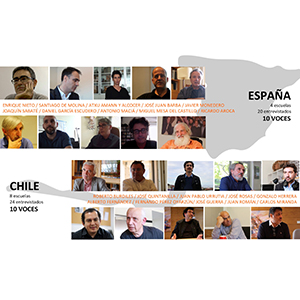University spirit in times of change
An intimate approach to architecture schools
DOI:
https://doi.org/10.35305/23626097v9i17.384Keywords:
architecture education, architecture schools, university structures, training communitiesAbstract
The following article reflects on certain changes that the current university structures and policies have transversely catalysed in architecture schools. Based on the results of a doctoral research and a series of interviews carried out in Chile and Spain with academics from various schools, it reveals the relationships between the mainly practical and intimate context of the formative process and that one shaped by the administrative and institutional sphere. Both contexts define a spectrum in which disciplinary training communities develop. From an intimate, qualitative approach, we dare to explore the ineffable university spirit arising in architecture schools under the influence of this spectrum. The aim is to set a starting point for an informed and contemporary reflection on the effects of the abstract regulatory frameworks for the dynamic and vital world of university education. This, in turn, seeks to envisage the possible futures in times of change.
Downloads
Metrics
References
Algaba Garrido, E. (2015). Universidad pública y privada en España: Dos modelos distintos con objetivos similares. Encuentros Multidisciplinares, 49, 1-10.
Awan, N., Schenider, T. y Till, J. (2011) Spatial Agency: other ways of doing architecture. Londres, UK: Routledge.
Bardí B., García Escudero, D. y Labarta, C. (2019). El aprendizaje de la arquitectura. ZARCH, 12, 2-7. Recuperado de: https://doi.org/10.26754/ojs_zarch/zarch.2019123387
Barrientos, M. (2020). Titulación y habilitación profesional del arquitecto en la era post Bolonia: Revisión y análisis comparativo de dos modelos representativos: Chile y España. (Tesis doctoral). Universidad de Alcalá, España y Universidad del Bío Bío, Chile. Recuperado de: https://ebuah.uah.es/dspace/handle/10017/45188?locale-attribute=es
Barrientos M., Goycoolea R. y Araneda C. (2022). Modelo universitario y prácticas docentes: Una mirada introspectiva de ocho escuelas de arquitectura chilenas. Revista AUS, 31,105-114.
Barros, L. P. (2011). Ideas en torno al Taller de Arquitectura. Valparaíso, Chile: Editorial USM.
Barros, L. P. (2015). Agenda propia. Recuperado de http://pablobarros.cl/files/writtings/Agenda%20propia.pdf
Bauman, Z. (2001). La sociedad individualizada. Madrid, España: Cátedra.
Bernasconi, A. (2017). Desafíos del futuro de la educación superior chilena. Santiago de Chile, Chile: Centro de políticas públicas UC. Recuperado de: Paper-N°-96-Desafíos-del-futuro-de-la-educación-superior-chilena.pdf
Bilello, J. (1991). Interaction and Interdependence: University-based Architectural Education and the Architectural Profession. Washington DC, USA: American Institute of Architects.
Brunner, J. (Ed). (2016). Educación superior en Iberoamérica [Informe 2016]. Santiago de Chile, Chile: Centro Interuniversitario de Desarrollo.
Butragueño, B., Raposo, J. F. y Salgado, M. A. (2018) Yes, we draw! El papel del dibujo en la pedagogía contemporánea de Arquitectura. JIDA, 18, 210-223.
Cunningham, A. (2005). Notes on education and research around architecture. The Journal of Architecture, 10(4), 415-441.
Doucet, I. (2017). Learning in the ‘Real’ World: encounters with radical architectures (1960s–1970s). Journal of Educational Administration and History, 49(1), 7-21.
Fuentealba, J., Barrientos, M., Goycoolea, R. y Araneda, C. (2019). El decisivo pero desatendido rol del sistema universitario en las escuelas de arquitectura. JIDA, 19, 168-179.
García Escudero, D. y Bardí, B. (2019). Conversación con Eva Franch i Gilabert: la pedagogía como espacio de experimentación. ZARCH 12, 200-209.
Greene, M., Scheerlinck, K. y Schoonjans, Y. (2012). The new architect. Towards a shared authorship. En D. Boutsen (Ed.) Good practices best practices. Highlighting the Compound Idea of Education, Creativity, Research and Practice (17-24) Bélgica, Bruselas: KU Leuven.
Jiménez, R. (2010). Formación por competencias en la enseñanza de la Arquitectura: ¿Un aporte? ¿Una necesidad? ¿O una moda? Revista Electrónica de Desarrollo de Competencias REDEC, 2(6), 65-83.
Kaplan, A. (2015). Artistas de lo invisible. Buenos Aires, Argentina: Antroposófica.
Monedero, J. (2003). Enseñanza y práctica profesional de la arquitectura en Europa y EEUU. Barcelona, España: Departament d'Expressió Gràfica Arquitectònica I, ETS d’Arquitectura de Barcelona.
Nieto, E. (2022). ¡Prescindible organizado! Agenda docente para una formulación afectiva y disidente del proyecto arquitectónico. Santiago de Chile, Chile: Editorial LOM.
Ockman, J. (Ed) (2012). Three Centuries of Educating Architects in North America. Cambridge, EEUU: The MIT Press.
Quetglas, J. (2012). La evolución de las escuelas de arquitectura. Palimpsesto, 4.
Sarquis, J. (2008). Producción de conocimiento en arquitectura, diseño y urbanismo. Buenos Aires, Argentina: Nobuko.
Torres, J. M. y Nieto, E. (2012). El modelo Alicante: disidencias espaciales en la enseñanza del proyecto de arquitectura [en línea]. Estudio Torres Nadal. Recuperado de: http://www.torresnadal.com/el-modelo-alicante-disidencias-espaciales-en-la-ensenanza-del-
proyecto-de-arquitectura/

Published
How to Cite
Issue
Section
License
Open access policy
A&P Continuidad is a non-profit and open access publication. According to Mexico Declaration on Cultural Policies, the journal distribution is submitted to Creative Commons Attribution-Noncommercial-ShareAlike 4.0 International Public License (CC BY-NC-SA). “Neither the commercial use of the original work nor that of the possible derivative works are allowed. The distribution of derivative works should be submitted to the license regulating the original work. This license is not free.”
A&P Continuidad authorizes the partial or full reproduction of texts and graphs provided that the source is cited. Authors are exclusively responsible for the criteria expressed in the articles which do not necessarily reflect the opinion of the Editorial Committee or that of the Direction Board. The copyright of the published articles pertains to their authors or publishers.
Transfer of rights
The acceptance of an article to be published implies the author’s transfer of rights to the journal. Authors continue to have the right to use the material in future books or publications, approve or veto the republication of their works as well as the rights related to patents or other rights. Transfer of rights form may be downloaded here.























 This OJS site and its metadata are under a
This OJS site and its metadata are under a 

